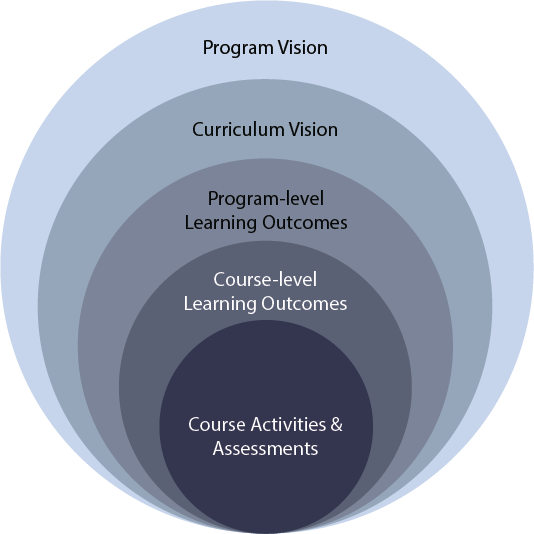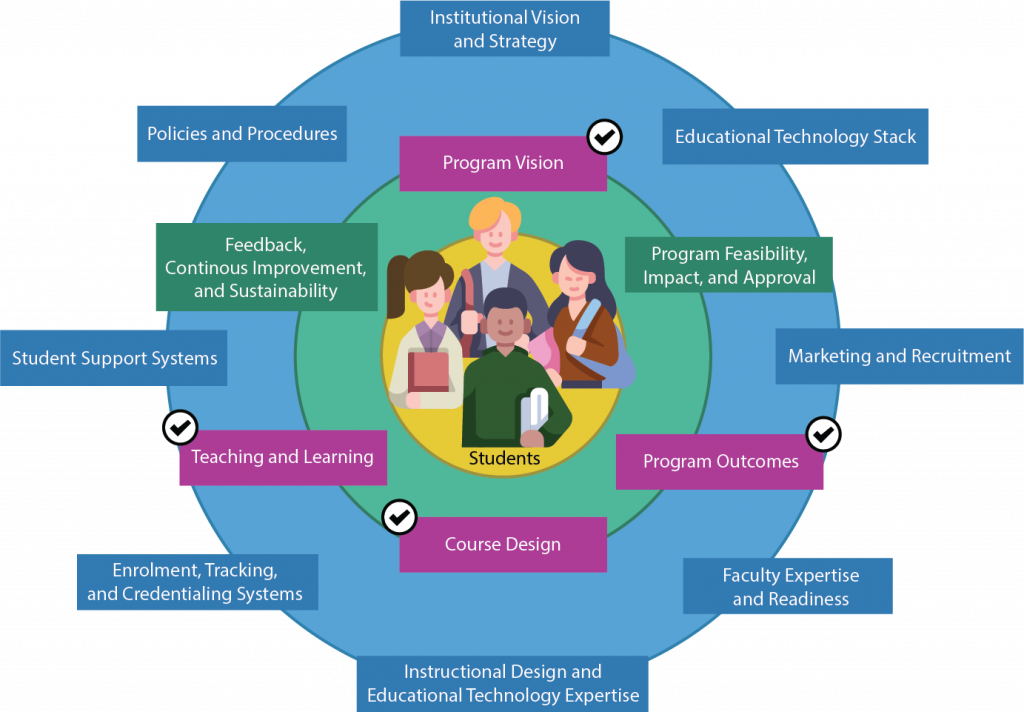Module 3: Course Design and Implementation
Program Design to Course Development
Lauren Anstey
Up to this point, you’ve developed a vision for the curricular structure of your program as a whole, and you’ve articulated program-level learning outcomes that determine what students will be able to know, value, and do by the end of the program.
How do you turn these visions and intended outcomes into a curriculum that supports learners from program entry to graduation?
The next step to program development is to plan the curriculum. Here, we introduce curriculum mapping as a flexible method for curriculum planning. The ultimate goal of curriculum mapping is to develop plans for student learning and assessment (i.e., through courses and other formalized learning experiences). This unit is focused on orienting academic leaders and program administrators to what curriculum mapping is and why it’s a recommended approach to curriculum development. With such a focus, the unit provides a high-level overview. For many academic leaders, this overview will provide sufficient context to key concepts and strategies for managing, guiding, or leading others to engage in a curriculum mapping process (e.g., your program design/development team).
Learning Outcomes
By the end of this unit, you will be able to:
- Articulate the value of curriculum mapping as an approach to visualizing connections between the program/curriculum visions, program outcomes, and course plans
- Plan and initiate a team-based conversation to initiate curriculum mapping for program development
You will take away:
- A plan for leading one’s program design team on curriculum mapping strategies for guiding course development
This unit focuses on the Program Outcomes, Program Vision, Course Design, Teaching and Learning elements of the Online Program Ecosystem. Read more about the ecosystem in Module 1, Unit 1: Collaborating to Create the Online Learner Life Cycle and its Ecosystem
We recognize that some readers will want more – they will want to get into the specifics of how to conduct curriculum mapping for program and course design. For this, we recommend Unit 4: Curriculum Mapping in this module – a separate unit that expands and elaborates on curriculum mapping at the program level.

Program and curriculum visions set the direction and overall intentions of a program and its curricular structure. For students to be successful in the program as a whole, everything they do for learning and assessment should aid them in progressing toward those goals.
The rationale for this unit is grounded in two related concepts – Constructive Alignment and Backward Design. When educators use curriculum mapping strategies, they engage constructive alignment and backwards design principles into curriculum planning.
The What and Why of Curriculum Mapping

Curriculum mapping is “the process of associating course outcomes with program‐level learning outcomes and aligning elements of courses (e.g., teaching and learning activities, assessment strategies) within a program, to ensure that it is structured in a strategic, thoughtful way that enhances student learning” (Dyjur, Grant, & Kalu, 2019, p. 4). Mapping enables designers to plan a course in a way that is strategically and thoughtfully aligned to program intended outcomes (Harden, 2001). While curriculum mapping is taken up in a variety of ways depending on the intended conversation, this unit applies the concept of curriculum mapping to the initial design and development of an academic program and the courses that will shape it.
A ‘map’ is commonly presented as a diagram, table, or matrix that visually shows the connections between elements of a curriculum, such as program learning outcomes, and course-based details, such as course outcomes, teaching & learning activities, or assessments.
Review the various images of curriculum maps below and click the question mark icons to reveal information about each. Map #1 (top) is an excerpt from a theoretical biology program curriculum matrix by the University of Hawaiʻi at Mānoa (2022). Map #2 (middle) is an example map by the Office of Teaching and Learning (n.d.) at the University of Guelph. Map #3 (bottom) is a map generated by Cecil & Krohn (2012) for a competency-based tourism program. Notice how no two maps look quite the same.
Why Engage in Curriculum Mapping?
The following list is adapted from Dyjur et al. (2019) to summarize the many benefits of curriculum mapping:
- It provides a view of the program’s curriculum as a whole (Jacobs & Johnson, 2009)
- Relationships within the curriculum can be easily identified, such as connections between learning outcomes, student assessments, and teaching and learning activities (Tariq, Scott, Cochrane, Lee, & Ryles, 2004)
- Engaging in mapping activities encourages communication amongst faculty members within a program (Metzler, Rehrey, Kurz, & Middendorf, 2017)
- Mapping conversations and resulting products provide opportunities for reflection (Fraser, Crook, & Park, 2007; Tariq et al., 2004)
- It helps faculty members to articulate tacit understandings about a program
- It provides a context for planning and discussing the curriculum
Curriculum mapping for new online program development seeks to devise initial plans for the arising course-level planning. Doing so frames the scope of each course to the individuals and teams who go on to develop each respective course. This helps to ensure that each course is developed within the decided bounds or scope of the intended learning outcomes.
Leading Curriculum Mapping
There is no singular “right” way to begin engaging in the curriculum mapping process for course design. The process must ultimately be organic to best serve your program and the program development team. In addition, curriculum mapping is a process of data collection requiring both dialogue and informed team-based decision-making about a program and its overall design. Since no one person singularly designs and teaches an entire academic program, no one person can possibly capture all the elements of program and course design into a curriculum map; it must be a team effort. Here are some ideas for collaborative mapping:
- Host a program retreat to engage in a curriculum mapping exercise as a group.
- Have each member of the team design their draft map, such as how they would represent the program visually or as a mind-map. Then, come together to share design ideas. Where your ideas compare and contrast could lead to exciting new revelations about the overall program structure and course design.
- Connect with stakeholders (e.g., prospective students of the program, recent graduates in a similar discipline, employers). Ask them: What should students learn in this program? What lasting knowledge, skills, values, or attitudes are important for graduates 5 years after graduation?
Unit Reflection and Resources
If you plan to engage in curriculum mapping – what’s your why? What value do you see in taking this approach? What would you like to get out of your curriculum mapping process?
Actionable Tasks
Review the list of benefits outlined in this unit and consider which benefits are most attractive to you.
|
Are you looking to… |
Consider the Following Mapping Approaches |
|
Build a visual overview of your program as a whole? |
Take high-level and visual approaches to mapping out the program as a whole |
|
Clarify or strengthen relationships within the curriculum, such as connections between learning outcomes, student assessments, and teaching and learning activities? |
Plan a curriculum map that’s designed to map the relationships you’re seeking to emphasize |
|
Engage in mapping activities to encourage communication amongst faculty members within a program? |
Prioritize collaborative approaches to mapping. Giving enough time and scheduled opportunities for conversation are essential here |
|
Engage in mapping to provide opportunities for reflection? |
Build time for conversation and reflection into the workflow |
|
Support curriculum designers and instructors to articulate tacit understandings about a program? |
Plan a curriculum mapping approach that requires input from your team and guides their input around those tacit understandings you’re seeking to clarify (e.g., where will students purposefully develop writing skills?) |
As you wrap up this unit, turn to your Program Design and Implementation Workbook. The activity outlined in the workbook poses some questions for consideration as you devise your plans for leading the program design team to engage in curriculum mapping strategies for course and curriculum development.
Constructive alignment is an "outcomes-based approach to teaching in which the learning outcomes that students are intended to achieve are defined before teaching takes place. Teaching and assessment methods are then designed to best achieve those outcomes and to assess the standard at which they have been achieved” (Biggs, 2014, p. 5).
Backward Design is an approach to design that starts with outcomes first, followed by a consideration of assessment: “What would the students have to do to convince me that they had achieved those learning goals?” Further followed by a question of learning: “What would the students need to do during the course to be able to do well on these assessment activities?” (Fink, 2013).

